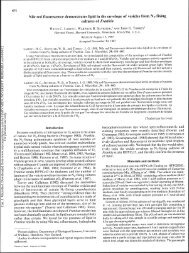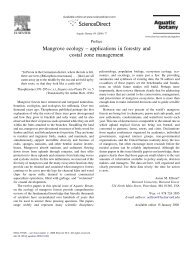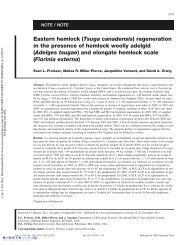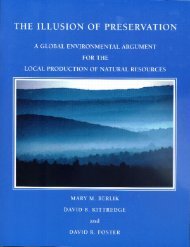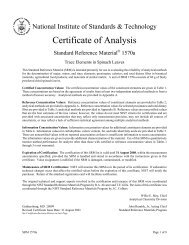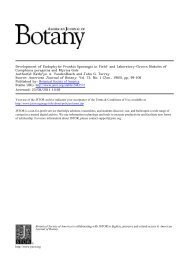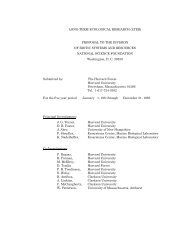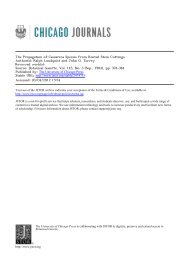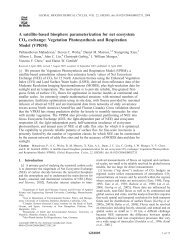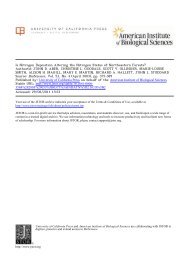Abstracts of Papers - Harvard Forest - Harvard University
Abstracts of Papers - Harvard Forest - Harvard University
Abstracts of Papers - Harvard Forest - Harvard University
Create successful ePaper yourself
Turn your PDF publications into a flip-book with our unique Google optimized e-Paper software.
Australian National <strong>University</strong>, Canberra, A.C.T.<br />
2601. - Differing ontogenetic origin <strong>of</strong> PCR<br />
("Kranz") sheaths in leaf blades <strong>of</strong> C, grasses<br />
(Poaceae)<br />
The origin and development <strong>of</strong> ground meristem and<br />
provascular tissue have been examined in leaf blades<br />
<strong>of</strong> eight C4 grasses, representing different taxonomic<br />
groups and the three recognized biochemical C4 types<br />
(NADP-ME, NAD-ME and PCK types). Comparisons were<br />
made with the C3 species, Festuca arundinacea (pooid).<br />
In NAD-ME (Panicum effusum, eupanicoid; Eleusine<br />
coracana, chloridoid) and PCK (Sporobolus elongatus,<br />
chloridoid) species, the provascular tissue <strong>of</strong><br />
primary veins gives rise to xylem, phloem and a<br />
mestome sheath; associated ground meristem differ-<br />
entiates as PCA ("C4 mesophyll") and the PCR ("Kranz")<br />
sheath. This parallels development in the C3 grass,<br />
except that associated ground meristem differentiates<br />
into mesophyll and a parenchymatous bundle sheath.<br />
By contrast, the provascular tissue <strong>of</strong> NADP-ME C4<br />
species (Panicum bulbosum and Digitaria brownii, eu-<br />
panicoid; Cymbopogon exaltatus, andropogonoid)<br />
differentiates into xylem, phloem and a PCR sheath;<br />
associated ground meristem giving rise only to PCA<br />
tissue. Findings support W.V. Brown's hypothesis<br />
that the PCR sheaths <strong>of</strong> NAD-ME and PCK-type C4 grasses<br />
are homologous with the parenchymatous bundle sheaths<br />
<strong>of</strong> C grasses, whereas in NAD-ME C4 grasses, they are<br />
homologous with mestome sheaths. Aristida<br />
biglandulosa and Arundinella nepalensis have unusual<br />
C4leaf anatomy <strong>of</strong> special interest to this hypo-<br />
thesis.<br />
DERSTINE, KITTIE S.* and SHIRLEY C. TUCKER.<br />
Department <strong>of</strong> Botany, Louisiana State <strong>University</strong>,<br />
Baton Rouge, LA 70803<br />
-Comparative floral ontogeny <strong>of</strong> Parkinsonia<br />
aculeata (Caesalpinioideae), Lupinus havardii<br />
(Papilionoideae) and Acacia baileyana (Mimos-<br />
oideae).<br />
The three subfamilies <strong>of</strong> Fabaceae are distinguished<br />
on the basis <strong>of</strong> floral symmetry, aestivation <strong>of</strong><br />
petals in bud (valvate or imbricate), degree <strong>of</strong><br />
fusion in calyx and corolla, and morphology <strong>of</strong> seeds<br />
and leaves. The first three characteristics will be<br />
addressed, using SEM primarily. Ontogenetic studies<br />
<strong>of</strong> a representative taxon in each subfamily are<br />
intended to determine when during development these<br />
diagnostic features first become evident. In each<br />
taxon, order <strong>of</strong> initiation <strong>of</strong> sepals and petals is<br />
used to establish first evidence <strong>of</strong> symmetry. Middle<br />
developmental stages elucidate first indications <strong>of</strong><br />
aestivation and/or apparent fusion among sepals,<br />
petals and filaments. Final flower form is seen in<br />
later developmental stages with petal expansion into<br />
divergent forms and cell differentiation as well as<br />
degree <strong>of</strong> filament fusion and further apparant petal<br />
fusion.<br />
DICKISON, WILLIAM C. Department <strong>of</strong> Biology,<br />
<strong>University</strong> <strong>of</strong> North Carolina, Chapel Hill, NC<br />
27514. - Fruits and seeds <strong>of</strong> the Cunoniaceae.<br />
Cunoniaceae fruit morphology varies from ventrally<br />
dehiscent follicles, and dry, septicidally dehiscent<br />
capsules, to dry, indehiscent capsules, fleshy<br />
drupes, berries, and winged fruit types. The fol-<br />
licular fruit is the primitive condition in the<br />
family from which dehiscent capsules and indehiscent<br />
forms evolved. The majority <strong>of</strong> species produce<br />
fruit in which the pericarp is differentiated into<br />
exocarp, mesocarp, and lignified, fibrous endocarp.<br />
Developmental and Structural Section 19<br />
Major shifts ih dispersal strategy resulted in more<br />
advanced taxa in which the entire fruit is modified<br />
for seed dispersal and protection. Most dehiscent-<br />
fruited genera produce seeds with dispersal append-<br />
ages in the form <strong>of</strong> wings or hairs. Hairs are<br />
generally apically comate, less commonly distributed<br />
in other patterns. Genera with indehiscent fruits<br />
possess a variety <strong>of</strong> seed morphologies but all are<br />
devoid <strong>of</strong> wings or hairs. Seed coats are exotegmic<br />
in construction, that is, the outer epidermis <strong>of</strong><br />
the inner integument differentiates into the<br />
mechanical layer. Two distinct trends are recog-<br />
nized in seed coat structure: (1) reduction in seed<br />
coat thickness, including loss <strong>of</strong> a mechanical layer,<br />
and (2) amplification <strong>of</strong> the seed coat by secondary<br />
divisions <strong>of</strong> integumentary cells in the post-<br />
fertilization ovule. The diversity <strong>of</strong> seed surface<br />
patterns will be described and illustrated.<br />
DIGGLE, PAMELA K.* and DARLEEN A. DEMASON. Botany<br />
and Plant Sciences, <strong>University</strong><br />
Riverside, 92521. - Developmental<br />
<strong>of</strong> California,<br />
relationship<br />
between the PTM and the STM in Yucca whipplei.<br />
Histological and anatomical observations were made<br />
on plants ranging from embryos to three-year-old<br />
plants <strong>of</strong> Yucca whipplei Torr. var. percursa Haines.<br />
Our objective was to determine the time and position<br />
<strong>of</strong> origin, ontogenetic relationship, and function<br />
<strong>of</strong> the primary thickening meristem (PTM) and the<br />
secondary thickening meristem (STM) during development<br />
<strong>of</strong> the vegetative axis. The PTM arises in<br />
the stem periphery during germination. It is longitudinally<br />
continuous from beneath the youngest<br />
leaf primordia to the primary root, and functions<br />
in the production <strong>of</strong> primary vascular bundles and<br />
ground tissue. The STM arises ontogenetically from<br />
the PTM in the base <strong>of</strong> two- to three-month seedlings<br />
and produces secondary vascular bundles and ground<br />
tissue. Parenchyma in the ground tissue is arranged<br />
in anticlinal cell files continuous from beneath the<br />
leaf bases, through the cortex and central cylinder<br />
to the pith. Individual vascular bundles in the<br />
primary body are collateral. The parenchyma cells<br />
<strong>of</strong> the ground tissue <strong>of</strong> the secondary body are also<br />
arranged in files continuous with those <strong>of</strong> the primary<br />
parenchyma. Secondary vascular bundles are<br />
amphivasal and have an undulating path with frequent<br />
anastomoses. The PTM and STM, primary and secondary<br />
vascular bundles, and files <strong>of</strong> primary and secondary<br />
ground tissue are continuous at all developmental<br />
stages studied. Development <strong>of</strong> the primary body is<br />
histologically and quantitatively similar to development<br />
in monocotyledons which possess only a PTI;<br />
and secondary growth is interpreted as a developmental<br />
continuation <strong>of</strong> the process <strong>of</strong> primary thickening.<br />
DUTE, ROLAND<br />
R. Department <strong>of</strong> Botany, Plant<br />
Pathology, and Microbiology, Auburn <strong>University</strong>,<br />
Auburn, AL 36849.<br />
- Features <strong>of</strong> sieve-element ontogeny in Ginkgo<br />
biloba.<br />
In an effort to enhance our knowledge <strong>of</strong> the phloem<br />
<strong>of</strong> gymnosperms, an ultrastructural investigation was<br />
conducted into the development <strong>of</strong> petiolar sieve<br />
elements <strong>of</strong> Ginkgo biloba. As in the sieve elements<br />
<strong>of</strong> other species, there is a stage <strong>of</strong> ER stacking<br />
which precedes cytoplasmic lysis. In some cases the<br />
ER forms concentric layers enclosing portions <strong>of</strong><br />
ribosome-rich cytoplasm. These concentric layers are<br />
held together by bridges <strong>of</strong> 7 nm in length which




